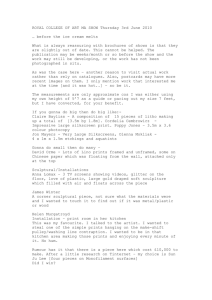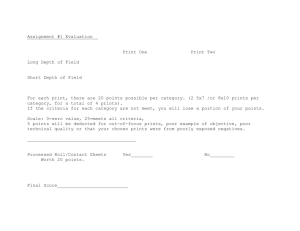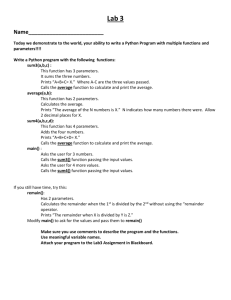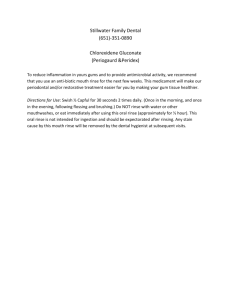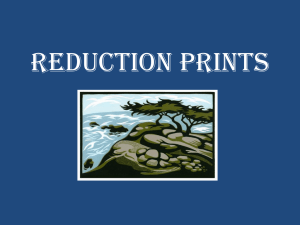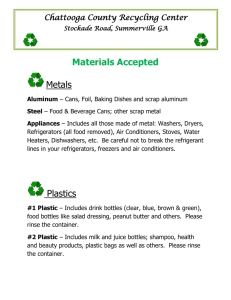SPP-40 - Educational Innovations
advertisement
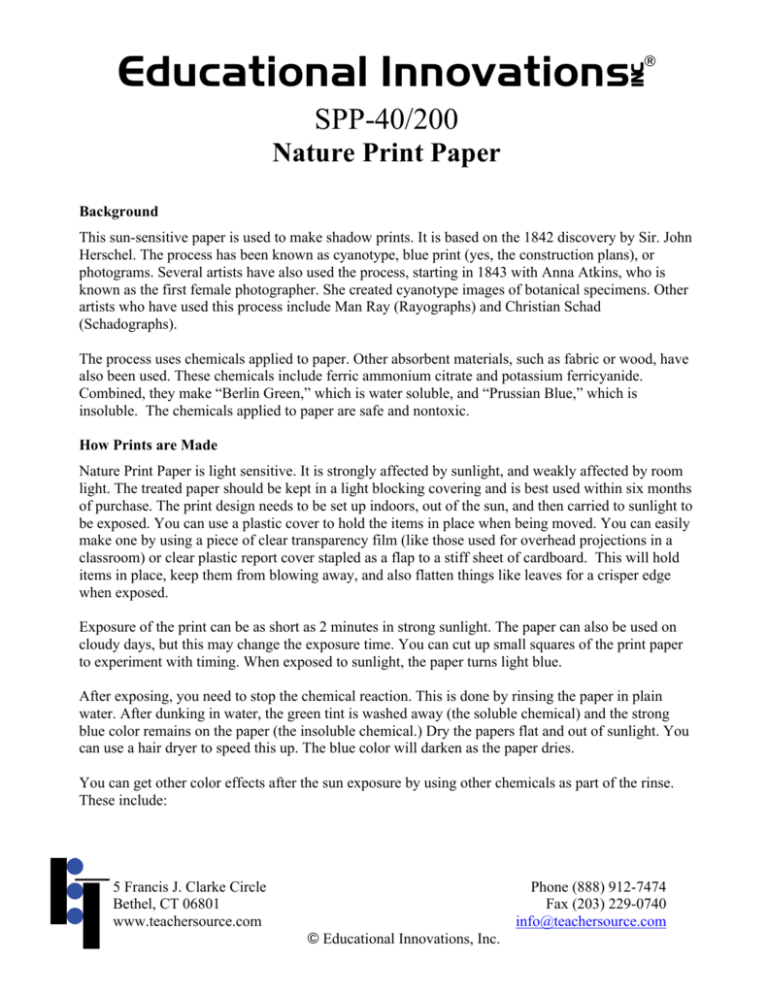
Educational Innovations ® SPP-40/200 Nature Print Paper Background This sun-sensitive paper is used to make shadow prints. It is based on the 1842 discovery by Sir. John Herschel. The process has been known as cyanotype, blue print (yes, the construction plans), or photograms. Several artists have also used the process, starting in 1843 with Anna Atkins, who is known as the first female photographer. She created cyanotype images of botanical specimens. Other artists who have used this process include Man Ray (Rayographs) and Christian Schad (Schadographs). The process uses chemicals applied to paper. Other absorbent materials, such as fabric or wood, have also been used. These chemicals include ferric ammonium citrate and potassium ferricyanide. Combined, they make “Berlin Green,” which is water soluble, and “Prussian Blue,” which is insoluble. The chemicals applied to paper are safe and nontoxic. How Prints are Made Nature Print Paper is light sensitive. It is strongly affected by sunlight, and weakly affected by room light. The treated paper should be kept in a light blocking covering and is best used within six months of purchase. The print design needs to be set up indoors, out of the sun, and then carried to sunlight to be exposed. You can use a plastic cover to hold the items in place when being moved. You can easily make one by using a piece of clear transparency film (like those used for overhead projections in a classroom) or clear plastic report cover stapled as a flap to a stiff sheet of cardboard. This will hold items in place, keep them from blowing away, and also flatten things like leaves for a crisper edge when exposed. Exposure of the print can be as short as 2 minutes in strong sunlight. The paper can also be used on cloudy days, but this may change the exposure time. You can cut up small squares of the print paper to experiment with timing. When exposed to sunlight, the paper turns light blue. After exposing, you need to stop the chemical reaction. This is done by rinsing the paper in plain water. After dunking in water, the green tint is washed away (the soluble chemical) and the strong blue color remains on the paper (the insoluble chemical.) Dry the papers flat and out of sunlight. You can use a hair dryer to speed this up. The blue color will darken as the paper dries. You can get other color effects after the sun exposure by using other chemicals as part of the rinse. These include: 5 Francis J. Clarke Circle Bethel, CT 06801 www.teachersource.com Phone (888) 912-7474 Fax (203) 229-0740 info@teachersource.com © Educational Innovations, Inc. To darken the final blue • Rinse the paper in a solution of water combined with vinegar or lemon juice. Rinse in plain water after to stop the final chemical reaction. Experiment with different concentrations of vinegar or lemon juice in the water with test squares to get the effect you would like to see. To lighten the final blue • Add some household borax or Sunlight brand laundry detergent to water for the first rinse solution. Rinse in plain water after to stop the final chemical reaction. Experiment with different concentrations of borax or detergent in the water with test squares to get the effect you would like to see. To change the color of the paper • Soak the water rinsed paper in a solution of brewed tea. Rinse quickly in plain water and dry the paper flat. This makes a peach to purple color in the final print. Experiment with different strengths of tea for different colors. Resources Read more about the history and process of cyanotypes at http://en.wikipedia.org/wiki/Cyanotype A middle elementary lesson using Sun Print paper, with extensions---from the Orange County Public Schools, Orlando, Florida www.mrsruss.com/Teachers/ResourceFiles/Science/35_Energy_FunInTheSun.pdf Photographs of British Algae by Anna Atkins, Flickr portfolio from the New York Public Library can be seen at http://www.flickr.com/photos/nypl/sets/72157610898556889/detail/ National Science Standards Grades K-4 Content Standard B Physical Science: Properties of Objects and Materials • Objects have observable properties (color and ability to react with other substances) Grades K-4 Content Standard B Physical Science: Position and Motion of Objects • The position of an object can be described by locating it relative to another object or the background Grades K-4 Content Standard B Physical Science: Light, Heat, Electricity, and Magnetism • Light travels in a straight line until it strikes and object. Light can be reflected by a mirror, refracted by a lens, or absorbed by the object. Grades 5-8 Content Standard B Physical Science: Properties and Changes of Properties in Matter • A substance has characteristic properties (solubility) © 2013 Educational Innovations, Inc. www.teachersource.com Next Generation Science Standards (Draft 2012) 1.LS Light and Sound • Investigate that some materials allow light to pass through, other only allow some light to pass through, and some materials block all of the light, creating a dark shadow. 4.E Energy • Carry out investigations that provide evidence that energy is transferred from place to place by sound, light, heat, electric currents, interacting magnets, and moving or colliding objects. Activities (appropriate for elementary grades) (middle grades with added research and reflection) Lower to Upper Elementary Making Shadows After investigations about objects that make shadows, those objects that create sharp distinct edges in their shadows, and those that create soft edges in their shadows, students can choose object to use in making Nature Prints. Each student might use small “sharp edge” items, and small “soft edge” items on his or her print to create contrasts. Identifying Plants in the School Yard Using plant and flower identification charts, take a schoolyard tour to map and identify the plants that live near your school. (Caution should be taken to scout the area for plants such as poison ivy ahead of time, and to discuss these with students, and avoid contact.) Make a collection of pieces or leaves from the identified plants in the schoolyard. Create a book or wall display of the plant prints, identifying each. Digital photos can also be used beside your Nature Prints. Have each child choose one plant as his or her favorite, create a Nature Print of this plant, and write an explanation of why it is his favorite. Poetry Prints After making Nature Prints, have students write haiku or other poetry to explain their pictures. Translucent and Transparent Investigate materials that are transparent (lets light pass through without being distorted) or translucent (lets light pass through, but makes it distorted or fuzzy in some way.) Examples are clear glass or plastic, vs. wavy or pebbled surface glass/plastic. Find object that can be tested on the Nature Print Paper to see what effects they have on the exposure prints. Of particular interest might be thin slices of foods like citrus or onions. Creating a Fair Test: Sunscreens © 2013 Educational Innovations, Inc. www.teachersource.com Students can develop a fair test of various sunscreen products using the Nature Print Paper. Discuss sunscreens, their purpose, and possible questions that can be investigated about the effectiveness of different products. Investigation questions might include: • how effective different products are (same SPF level/same amount/same exposure) • application (thin coat vs. thicker coat/same product) • different strengths (different SPF levels/same amount/same exposure) Students can also experiment with different exposure times, but these may be difficult to control for using Nature Print Paper. Have students bring in small samples (one ounce) of sunscreen lotions from home (provide small plastic bottles or covered cups from takeout restaurants). Use several sample bottles in the classroom for the students to read product information and to develop a data collection sheet that will include necessary information (i.e.: brand, SPF factor, type of product, cost per ounce, etc) of the samples they bring in from home. Students should also discuss and decide on the classroom procedure to create a fair test of their samples. Consideration should be given to things like how to identify the samples, how to test the lotions or sprays (using a clear overlay, like plastic, rather than applying directly to the Nature Print Paper), standardizing application amounts (amount of product, applied how, and over what sized area), and standardized sun exposure times. Carry out the procedure and collect data on the performance of the products. Discuss as a class how the performance can be measured and graphed. Discuss and reflect on the results of the experiment and the real-world consequences that can be derived from the information gathered. General Use and Ideas Nature Prints can be used to make gift cards, and to illustrate writings about the objects used to make them. Nature Prints can be mounted on card stock and cut up to create puzzles for students to reassemble---a simple shape, such as bookmarks, should be used to make these puzzle pieces, as the students should be concentrating on the picture, rather than the large shape of the puzzle piece. (Puzzles can be identified on the back with writing that crosses over the whole size of the card stock, such as the name of the child who made that print. This can be used to identify if the shapes belong to this print, or if they were assembled correctly.) Written by Laurel Kohl, Education Consultant © 2013 Educational Innovations, Inc. www.teachersource.com
